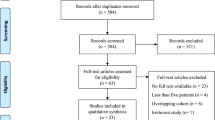Abstract
Reconstruction of large abdominal wall defects is often a challenge for both surgeons and patients. Preoperative conditioning prior to surgery can be crucial for success. Administration of botulinum toxin A (BTA) in the lateral abdominal wall for stretching the musculature seems to provide myofascial advancement and enlargement of the torso diameter. Although the use of BTA has increased since its introduction in 2009, the current evidence on both its safety and efficacy, as well as on its exact role in the treatment algorithm of these types of hernias, remains undetermined. In this chapter, we aim to give a complete overview on the current evidence on the use of BTA in abdominal wall reconstruction.
Access this chapter
Tax calculation will be finalised at checkout
Purchases are for personal use only
Similar content being viewed by others
References
DuBay DA, et al. Incisional herniation induces decreased abdominal wall compliance via oblique muscle atrophy and fibrosis. Ann Surg. 2007;245:140–6.
Deerenberg EB, et al. A systematic review of the surgical treatment of large incisional hernia. Hernia. 2015;19:89–101.
Gillion J-F, et al. The economic burden of incisional ventral hernia repair: a multicentric cost analysis. Hernia. 2016;20:819–30.
Bosanquet DC, et al. Systematic review and meta-regression of factors affecting midline incisional hernia rates: analysis of 14 618 patients. PLoS One. 2015;10(9):e0138745.
Walming S, et al. Retrospective review of risk factors for surgical wound dehiscence and incisional hernia. BMC Surg. 2017;17(1):19.
Muysoms F, et al. Classification of primary and incisional abdominal wall hernias. Hernia. 2009;13(4):407–14.
Slater NJ, et al. Criteria for definition of a complex abdominal wall hernia. Hernia. 2014;18(1):7–17.
Mujander A, et al. Assessment of myofascial medialization following posterior component separation via transversus abdominis muscle release in a cadaveric model. Hernia. 2018;22:637–44.
Tanaka E, et al. A computerized tomography scan method for calculating the hernia sac and abdominal cavity volume in complex large incisional hernia with loss of domain. Hernia. 2010;14:63–9.
Ramirez OM, et al. “Components separation” method for closure of abdominal-wall defects: an anatomic and clinical study. Plast Reconstr Surg. 1990;86:519–26.
Novitsky YW, et al. Transversus abdominis muscle release: a novel approach to posterior component separation during complex abdominal wall reconstruction. Am J Surg. 2012;204:709–16.
Kakmak M, et al. Effect of paralysis of the abdominal wall muscles by botulinum A toxin to intraabdominal pressure: an experimental study. J Pediatr Surg. 2006;41:821–5.
Ibarra-Hurtado T, et al. Use of botulinum toxin type A before abdominal wall hernia reconstruction. World J Surg. 2009;33:2553–6.
Renard Y, Lardière-Deguelte S, de Mestier L, et al. Management of large incisional hernias with loss of domain: a prospective series of patients prepared by progressive preoperative pneumoperitoneum. Surgery. 2016;160(2):426–35. https://doi.org/10.1016/j.surg.2016.03.033.
Zielinski M, et al. Chemical components separation with botulinum toxin A: a novel technique to improve primary fascial closure rates of the open abdomen. Hernia. 2013;17:101–7.
Ibarra-Hurtado T, et al. Effect of botulinum toxin type A in lateral abdominal wall muscles thickness and length of patients with midline incisional hernia secondary to open abdomen management. Hernia. 2014;18:647–52.
Farooque F, et al. Preoperative abdominal muscle elongation with botulinum toxin A for complex incisional ventral hernia repair. ANZ J Surg. 2015;86:79–83.
Elstner K, et al. Laparoscopic repair of complex ventral hernia facilitated by pre-operative chemical component relaxation using Botulinum Toxin A. Hernia. 2016;20:209–19.
Elstner K, et al. Preoperative chemical component relaxation using Botulinum toxin A: enabling laparoscopic repair of complex ventral hernia. Surg Endosc. 2017;31:761–8.
Motz BM, et al. Chemical components separation: concepts, evidence, and outcomes. Plast Reconstr Surg. 2018;142(3 Suppl):58S–63S.
Bueno-Lledó J, et al. Preoperative combination of progressive pneumoperitoneum and botulinum toxin type A in patients with loss of domain hernia. Surg Endosc. 2018;32(8):3599-3608. doi:10.1007/s00464-018-6089-0
Zendejas B, et al. Outcomes of chemical component paralysis using Botulinum Toxin for incisional hernia repairs. World J Surg. 2013;37:2830–7.
Rodriguez-Acevedo O, et al. Preoperative botulinum toxin A enabling defect closure and laparoscopic repair of complex ventral hernia. Surg Endosc. 2018;32:831–9.
Smoot D, et al. Botox A injection for pain after laparoscopic ventral hernia: a case report. Pain Med. 2011;12:1121–3.
Lien SC, et al. Contraction of abdominal wall muscles influences incisional hernia occurrence and size. Surgery. 2015;158(1):278–88.
Tomazini Martins R, et al. Limitations of electromyography in the assessment of abdominal wall muscle contractility following botulinum toxin A injection. Front Surg. 2019;9(6):16.
López-Cano M, Armengol-Carrasco M. Chemical component separation using botulinum toxin. In: Hernia surgery: current principles. Cham: Springer; 2016. p. 421–36.
Nielsen MO, et al. Short-term safety of preoperative administration of botulinum toxin A for the treatment of large ventral hernia with loss of domain. Hernia. 2020;24(2):295–9.
Dressler D, Saberi FA. Safety of botulinum toxin short interval therapy using incobotulinumtoxin A. J Neural Transm. 2017;124:437–40.
Soltanizadeh S, et al. Botulinum toxin A as an adjunct to abdominal wall reconstruction for incisional hernia. Plast Reconstr Surg Glob Open. 2017;5(6):e1358.
Yurtkap Y, van Rooijen MMJ, Roels S, et al. Implementing preoperative Botulinum toxin A and progressive pneumoperitoneum through the use of an algorithm in giant ventral hernia repair [published online ahead of print, 2020 Jun 3]. Hernia. 2020. https://doi.org/10.1007/s10029-020-02226-2.
Author information
Authors and Affiliations
Corresponding author
Editor information
Editors and Affiliations
Rights and permissions
Copyright information
© 2020 Springer Nature Switzerland AG
About this chapter
Cite this chapter
Mathias, A., Frederik, B. (2020). Botulinum Toxin A in Abdominal Wall Reconstruction. In: Jabbari, B. (eds) Botulinum Toxin Treatment in Surgery, Dentistry, and Veterinary Medicine. Springer, Cham. https://doi.org/10.1007/978-3-030-50691-9_8
Download citation
DOI: https://doi.org/10.1007/978-3-030-50691-9_8
Published:
Publisher Name: Springer, Cham
Print ISBN: 978-3-030-50690-2
Online ISBN: 978-3-030-50691-9
eBook Packages: Biomedical and Life SciencesBiomedical and Life Sciences (R0)




